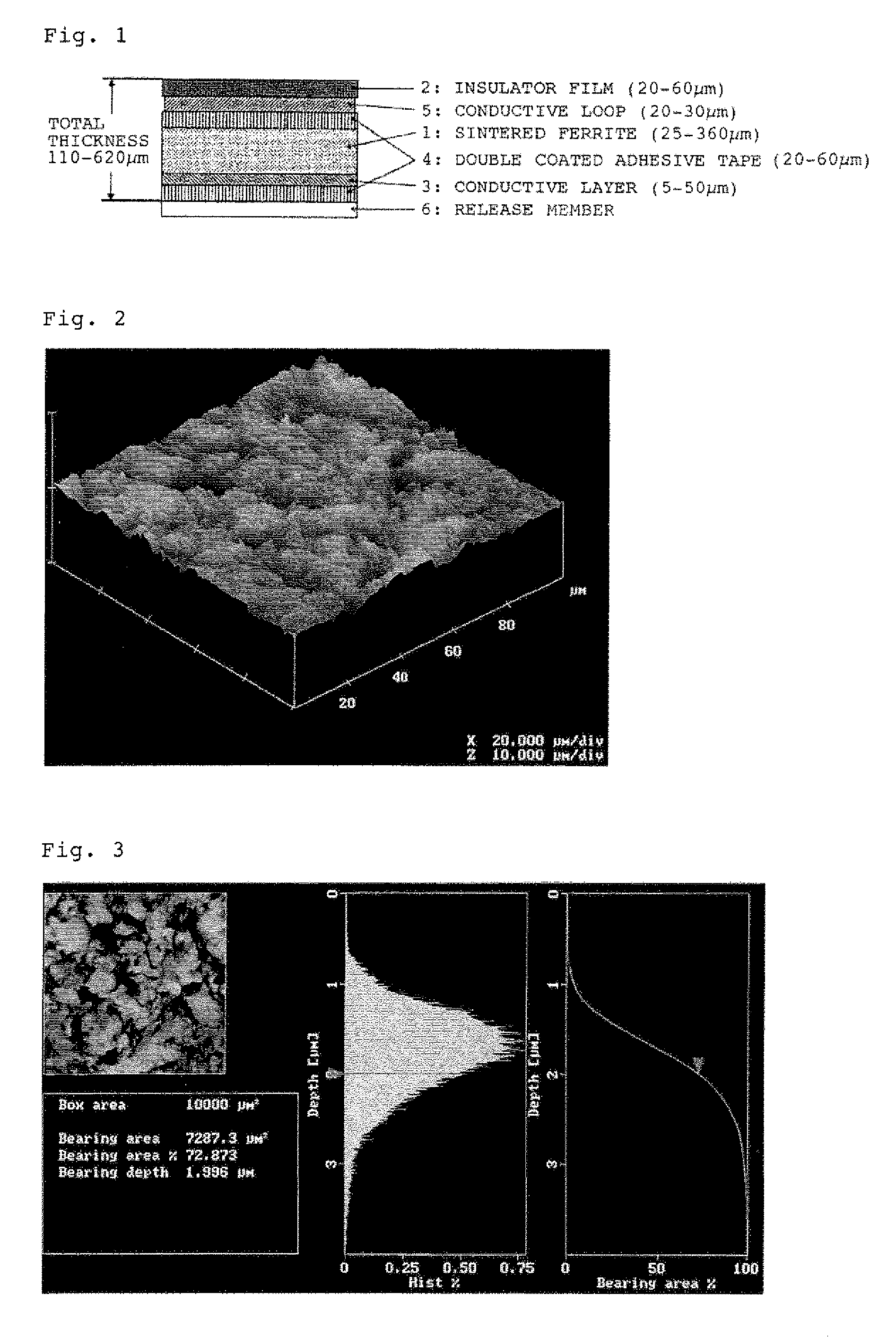Molded ferrite sheet, sintered ferrite substrate and antenna module
a technology of sintered ferrite and substrate, applied in the direction of magnetic bodies, record information storage, synthetic resin layered products, etc., can solve the problems of contaminating electronic precision components, affecting the quality of the antenna, and affecting the performance of the antenna
- Summary
- Abstract
- Description
- Claims
- Application Information
AI Technical Summary
Benefits of technology
Problems solved by technology
Method used
Image
Examples
example 1
[0125]Using a pressure kneader, 1,000 parts by weight of a ferrite powder, obtained by surface-treating 1,000 parts by weight of Ni—Zn—Cu ferrite powder (composition: Fe2O3: 48.5 mol %, NiO: 20.5 mol %, ZnO: 20.5 mol %, CuO: 10.5 mol %; calcinations conditions: 850° C., 90 minutes; cumulative 50% volume diameter: adjusted to 0.7 μm) with 10 parts by weight of a titanate-based coupling agent (KR-TTS manufactured by Ajinomoto Co., Inc.), 50 parts by weight of a thermoplastic elastomer (LUMITAC 22-1 manufactured by Tosoh Corporation), 100 parts by weight of polyethylene having a density of 0.9 g / cm3 and 20 parts by weight of stearic acid were kneaded at 130° C. for 40 minutes. The thus obtained kneaded mass of a ferrite resin composition was press molded at a temperature of 160° C. under a pressure of 100 kg / cm2 for a pressurization time of 3 minutes using an iron plate, which had been sandblasted to have a center line average roughness of 450 nm and a maximum height of 8 μm, to obtain...
example 2
[0127]Using a ball mill, 100 parts by weight of the same Ni—Zn—Cu ferrite as used in Example 1, 2 parts by weight of butyl phthalyl butyl glycolate, 12 parts of a polyvinylalcohol resin (ESLEK B BM-1 manufactured by Sekisui Chemical Co., Ltd.) and 60 parts by weight of a mixed solvent composed of 4 parts of n-butanol and 6 parts of toluene were mixed, dissolved or dispersed to obtain a ferrite-dispersed coating liquid. The ferrite-dispersed coating liquid was defoamed by an oil rotary vacuum pump and uniformly applied with a doctor blade to a PET film (LUMIMAT 50S200 TRES manufactured by Panak Co., Ltd.), one side of which had been sandblasted to have a center line average roughness of 530 nm and a maximum height of 5.6 μm, to a given thickness. The coating was dried with hot wind at 100° C. for 30 minutes to obtain a molded ferrite sheet having a thickness of 204 μm. The molded ferrite sheet was cut into squares of side 100 mm. Each of the cut sheets was peeled off from the PET fil...
example 3
[0129]A kneaded mass of a ferrite resin composition was prepared in the same manner as that in Example 1 except that a mixture of 300 parts by weight of Ni—Zn—Cu ferrite powder (composition: Fe2O3: 48.5 mol %, NiO: 20.5 mol %, ZnO: 20.5 mol %, CuO: 10.5 mol %; calcination conditions: 1,000° C., 90 minutes; cumulative 50% volume diameter: 6 μm) and 700 parts by weight of the same Ni—Zn—Cu ferrite powder (cumulative 50% volume diameter: 0.7 μm) as used in Example 1 was used. The thus obtained kneaded mass was press molded at a temperature of 160° C. under a pressure of 100 kg / cm2 for a pressurization time of 3 minutes using an iron plate, which had been processed to have a center line average roughness of 120 nm and a maximum roughness of 2 μm, to obtain a molded ferrite sheet having a thickness of 200 μm and an outer size of 100 mm. Using the thus obtained sheet, sintered ferrite substrates were prepared in the same manner as that in Example 1. The obtained sintered ferrite substrate...
PUM
| Property | Measurement | Unit |
|---|---|---|
| thickness | aaaaa | aaaaa |
| roughness | aaaaa | aaaaa |
| height | aaaaa | aaaaa |
Abstract
Description
Claims
Application Information
 Login to View More
Login to View More - R&D
- Intellectual Property
- Life Sciences
- Materials
- Tech Scout
- Unparalleled Data Quality
- Higher Quality Content
- 60% Fewer Hallucinations
Browse by: Latest US Patents, China's latest patents, Technical Efficacy Thesaurus, Application Domain, Technology Topic, Popular Technical Reports.
© 2025 PatSnap. All rights reserved.Legal|Privacy policy|Modern Slavery Act Transparency Statement|Sitemap|About US| Contact US: help@patsnap.com



